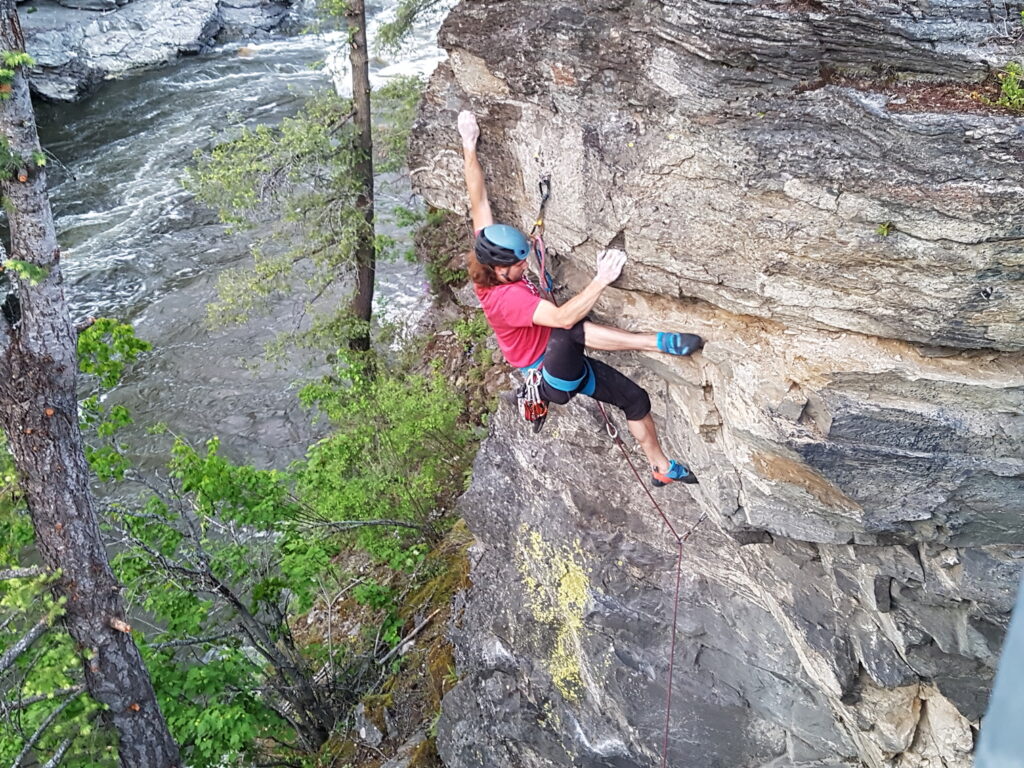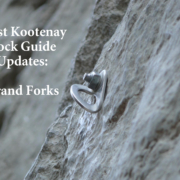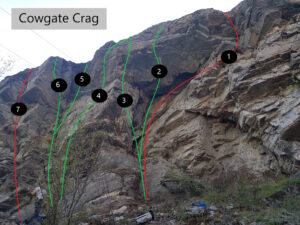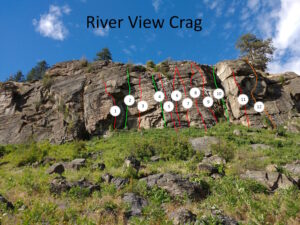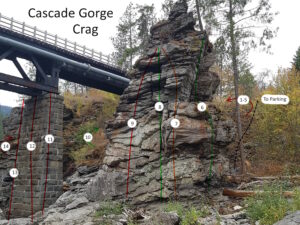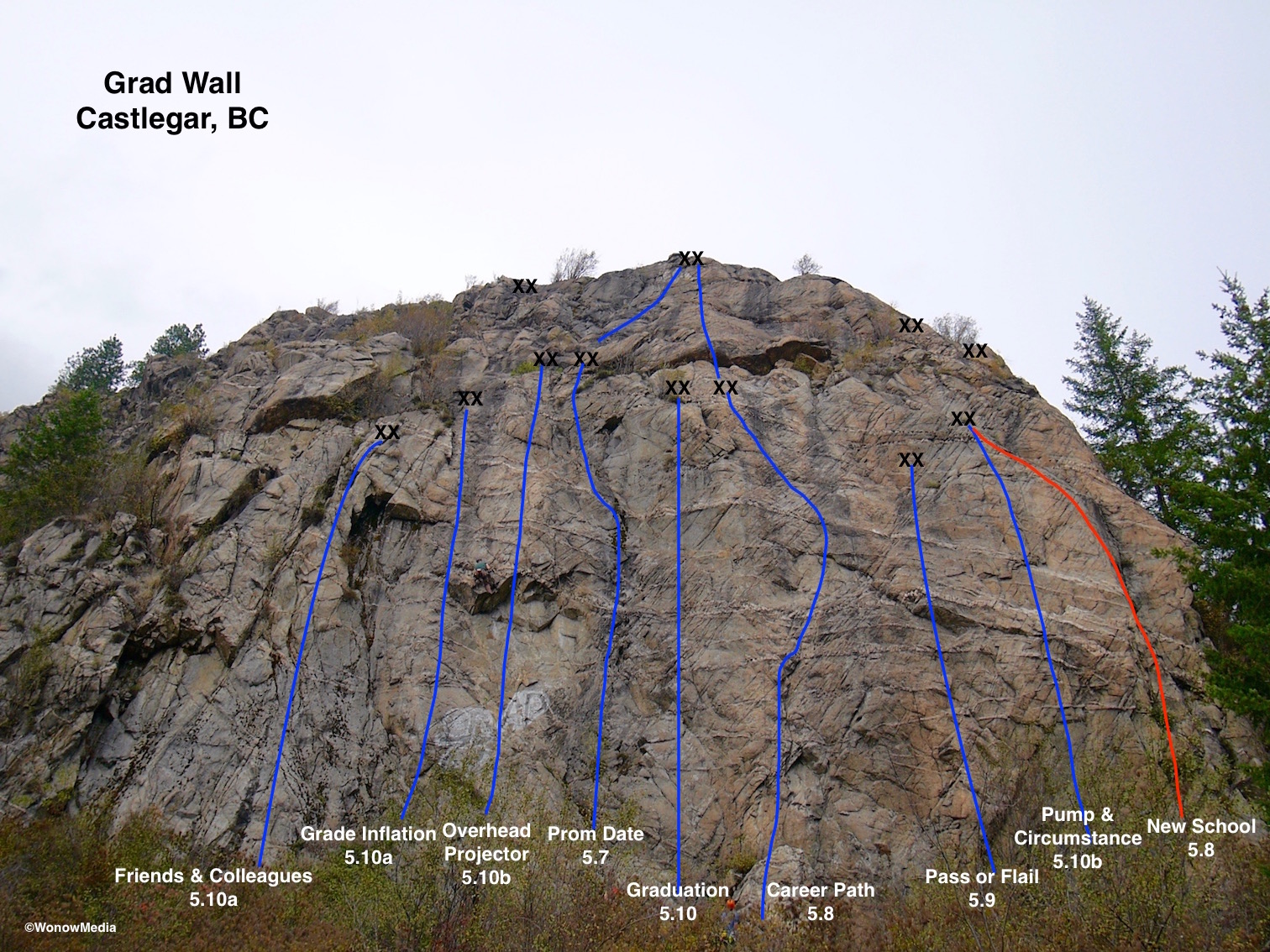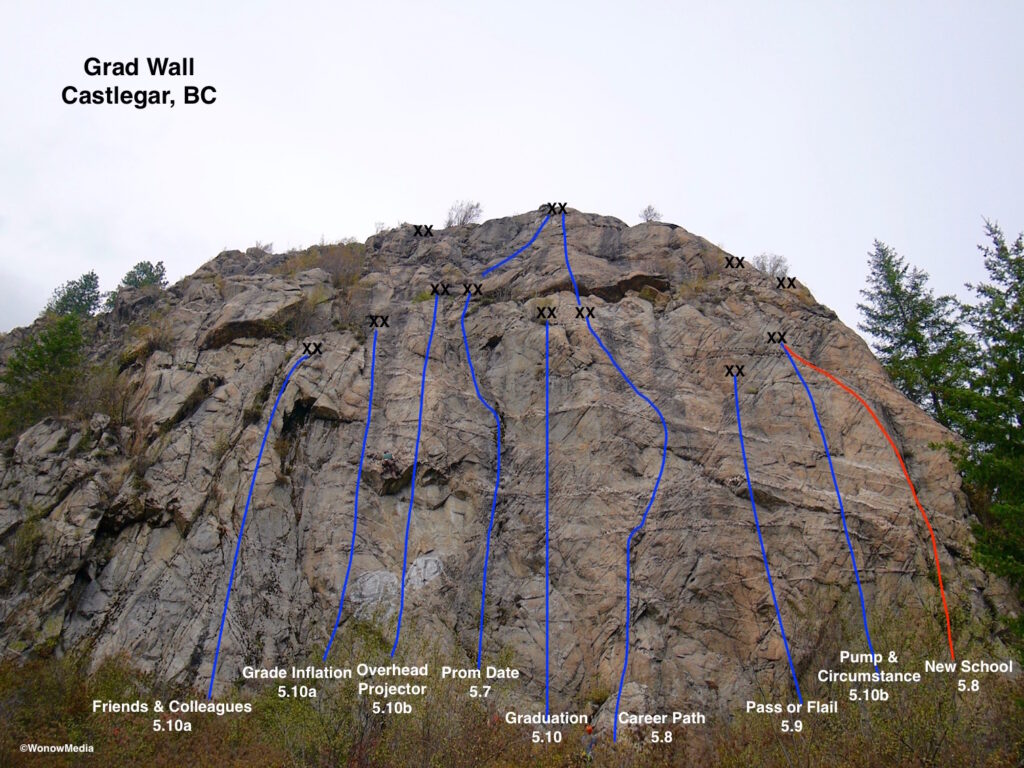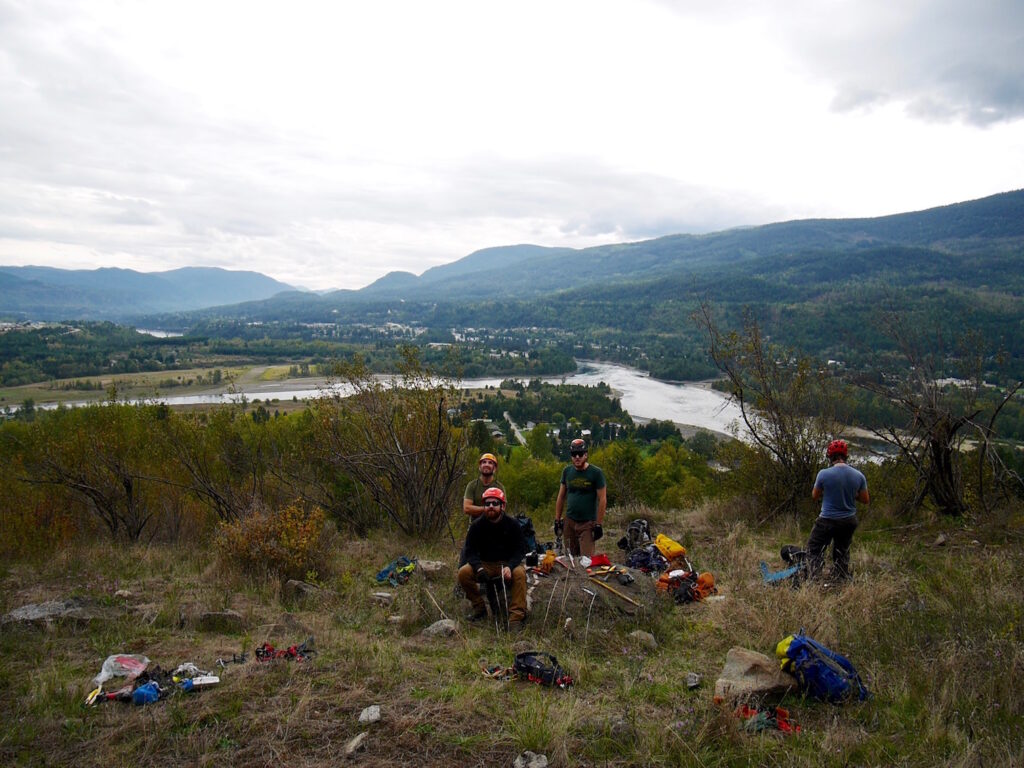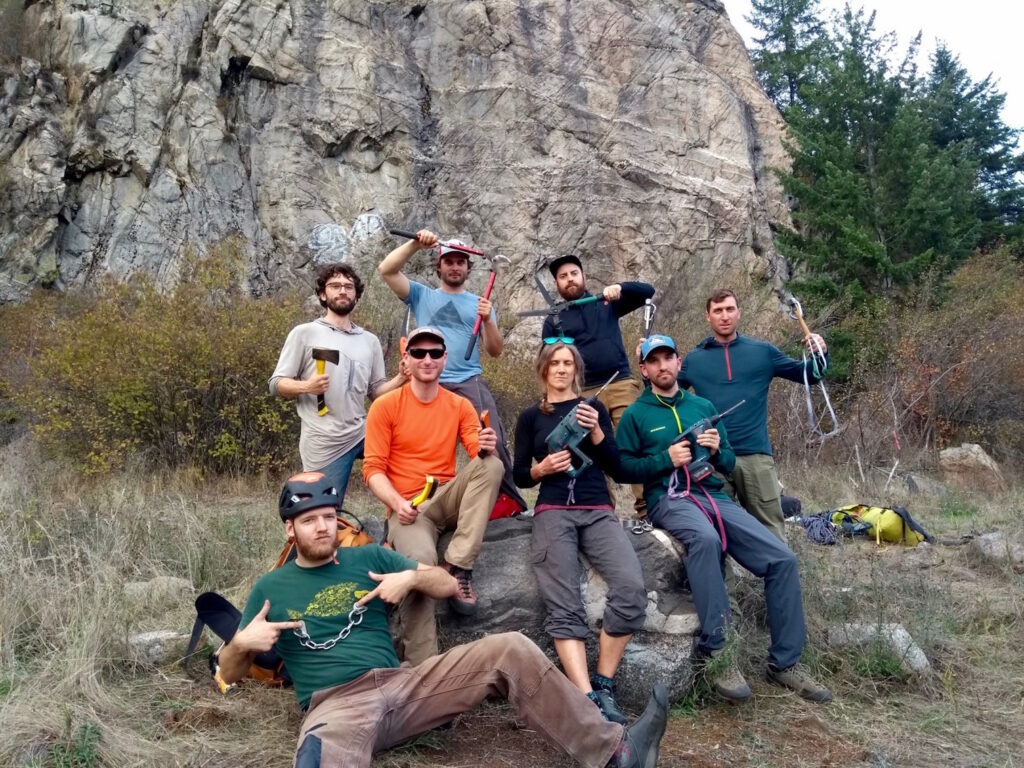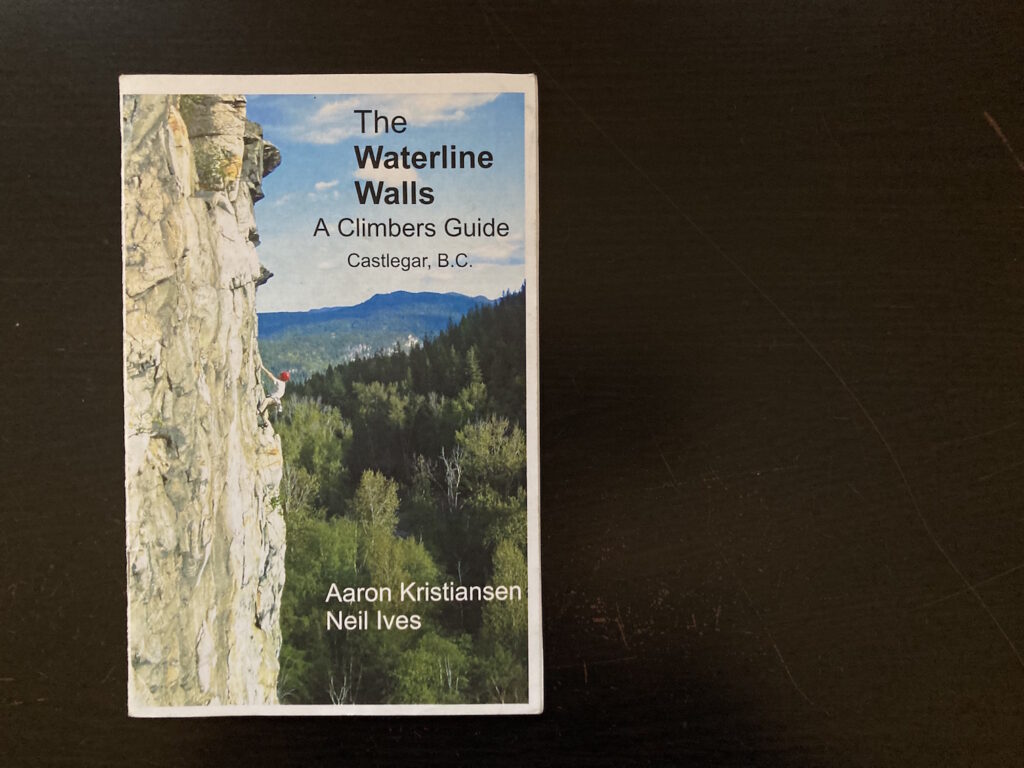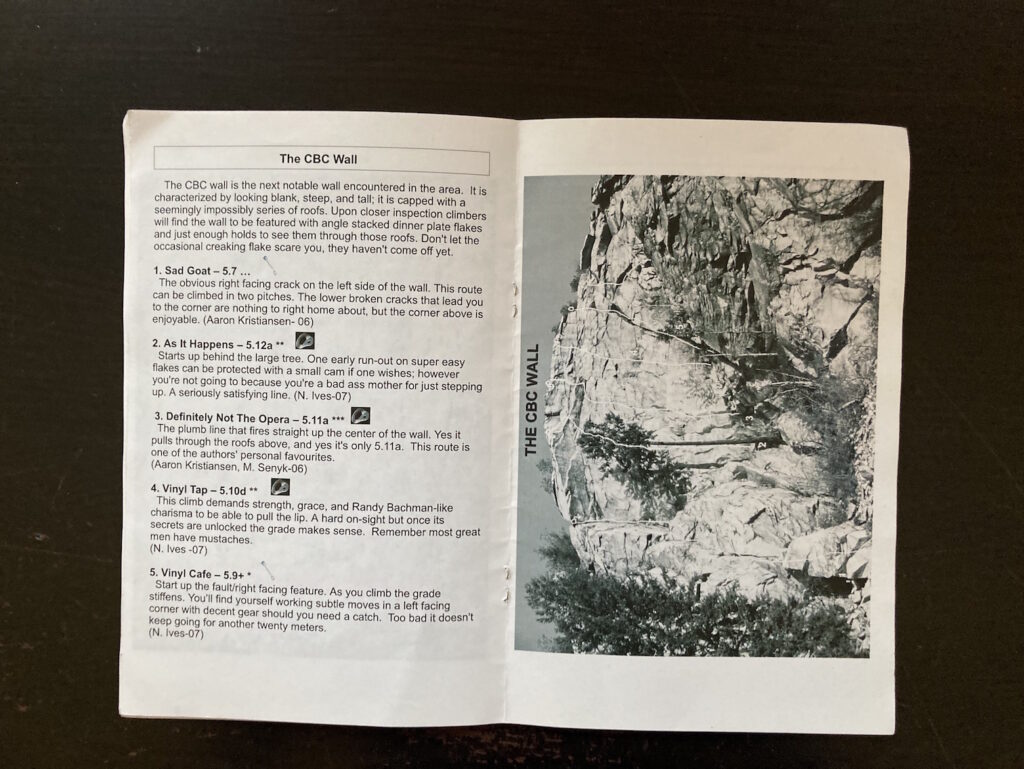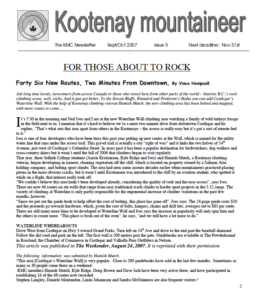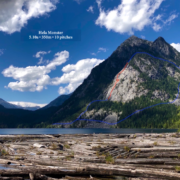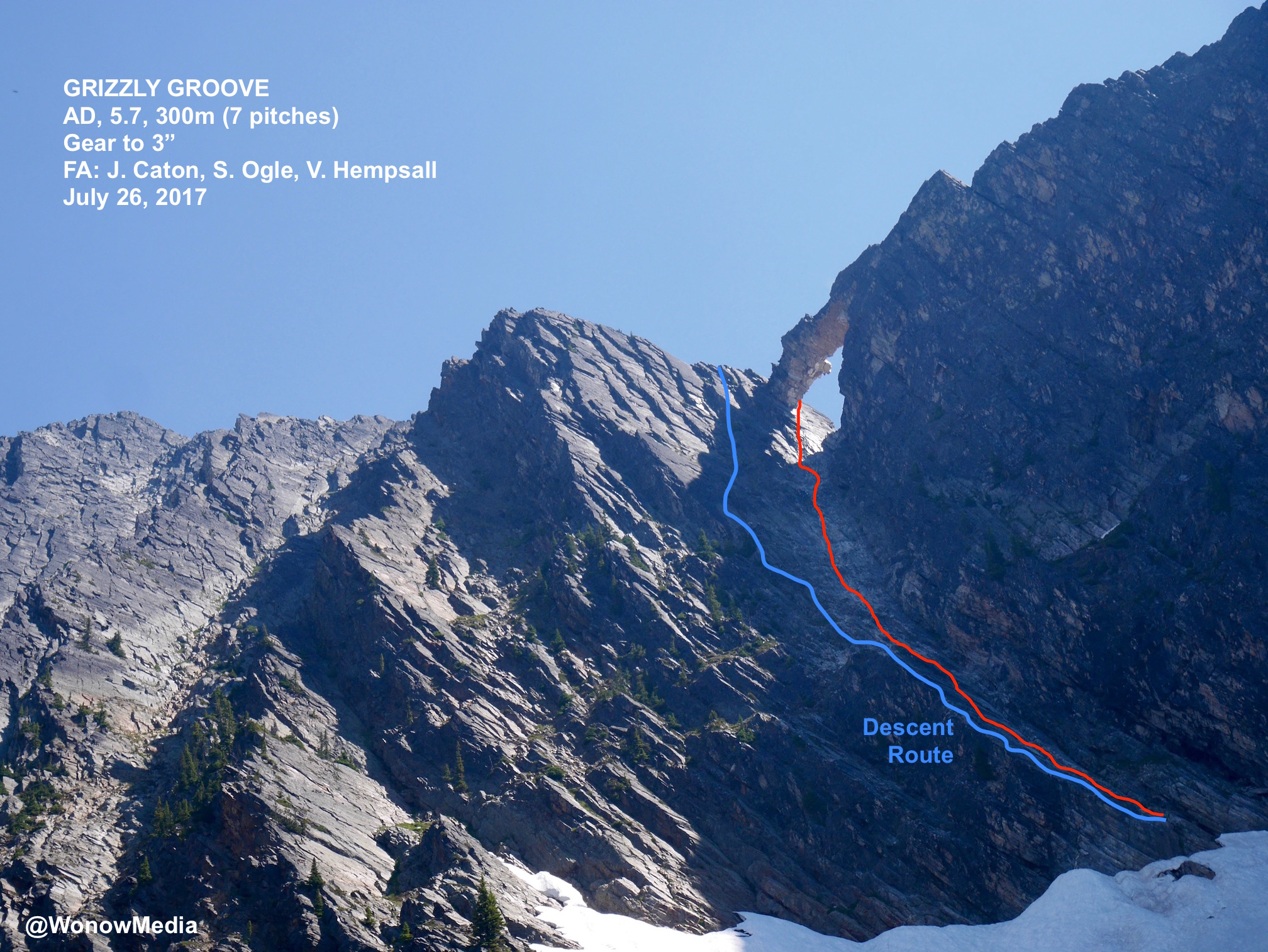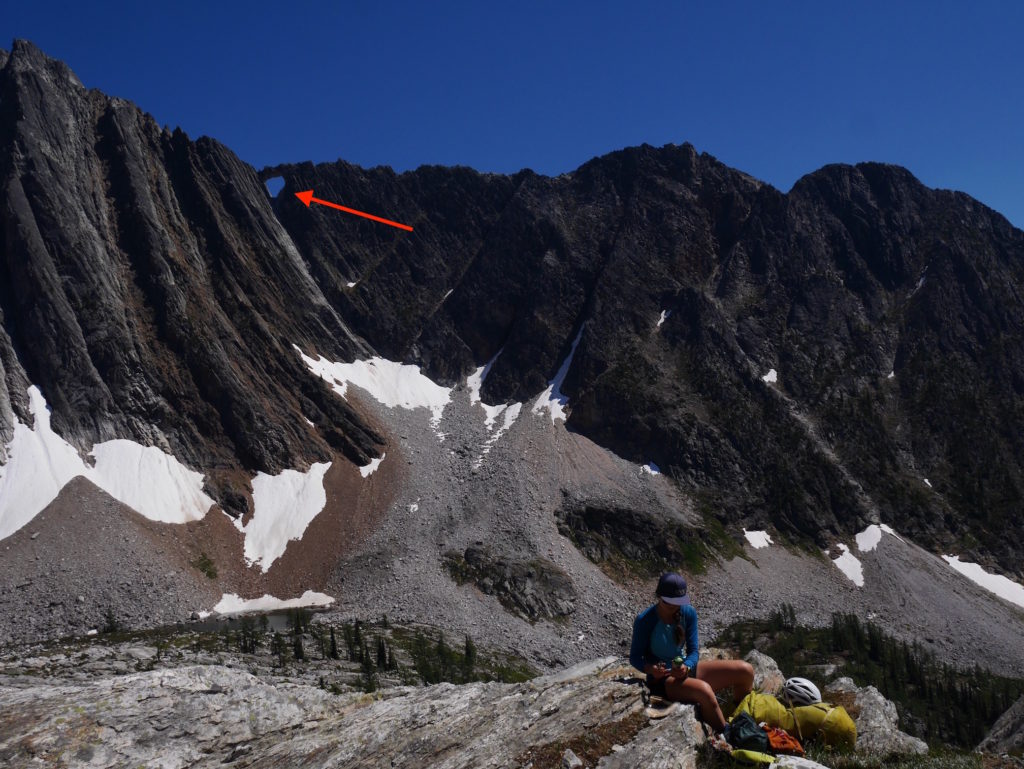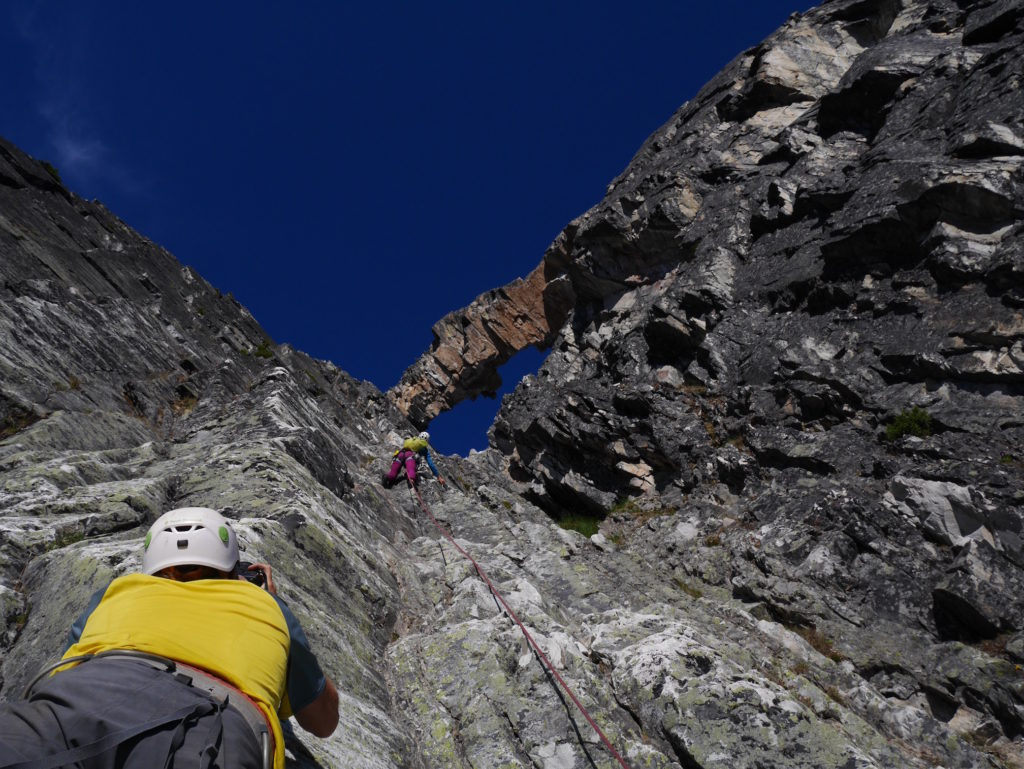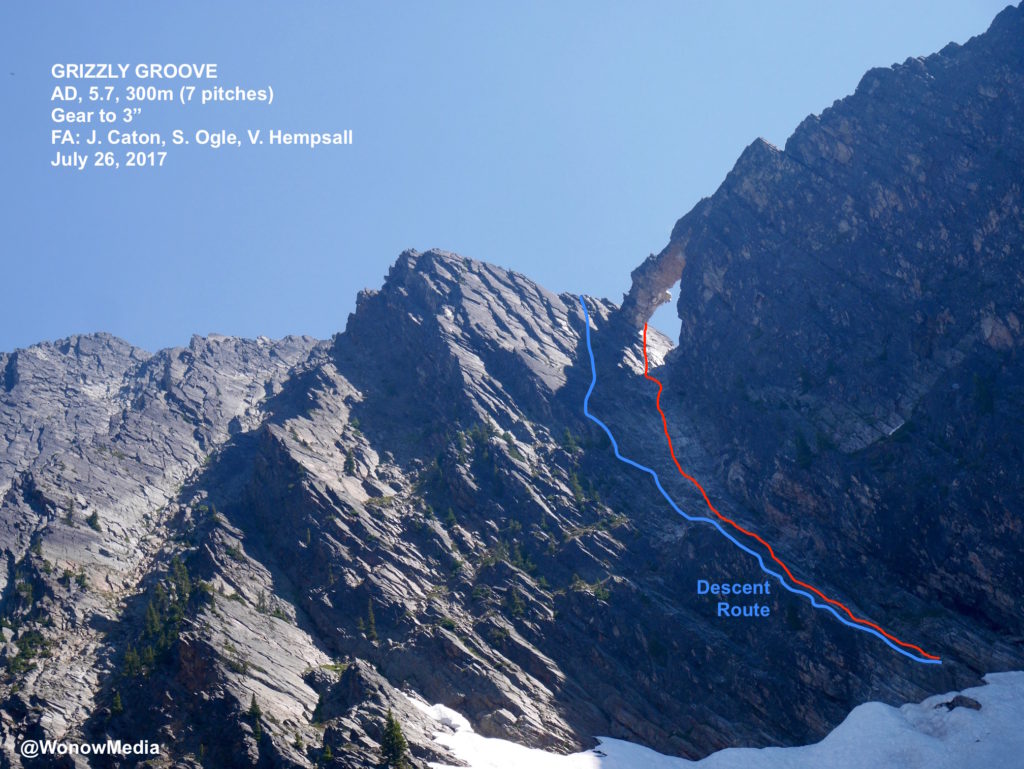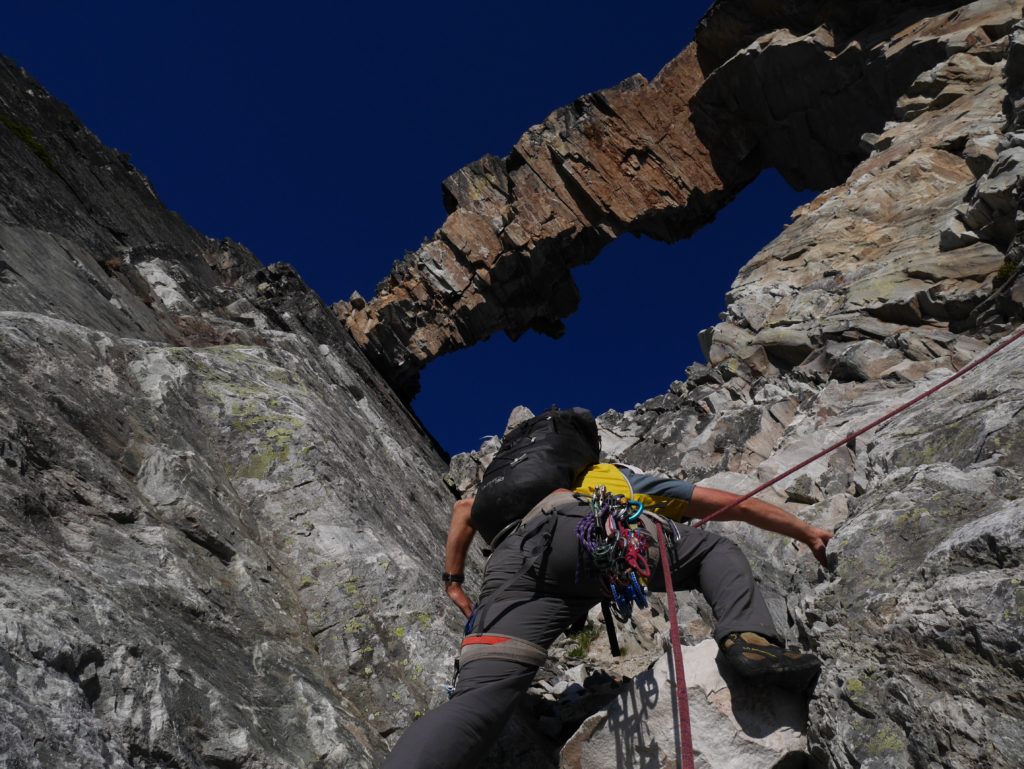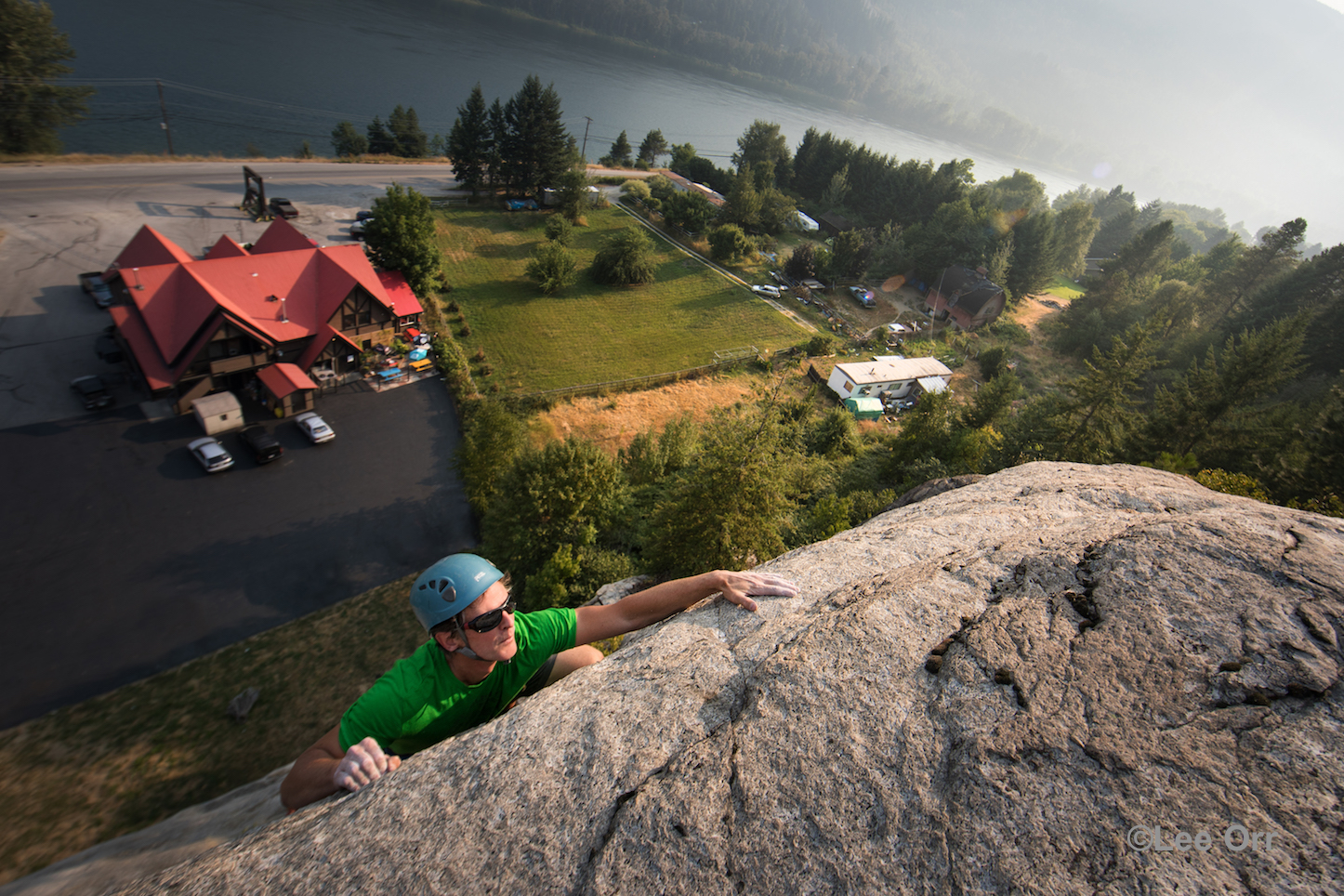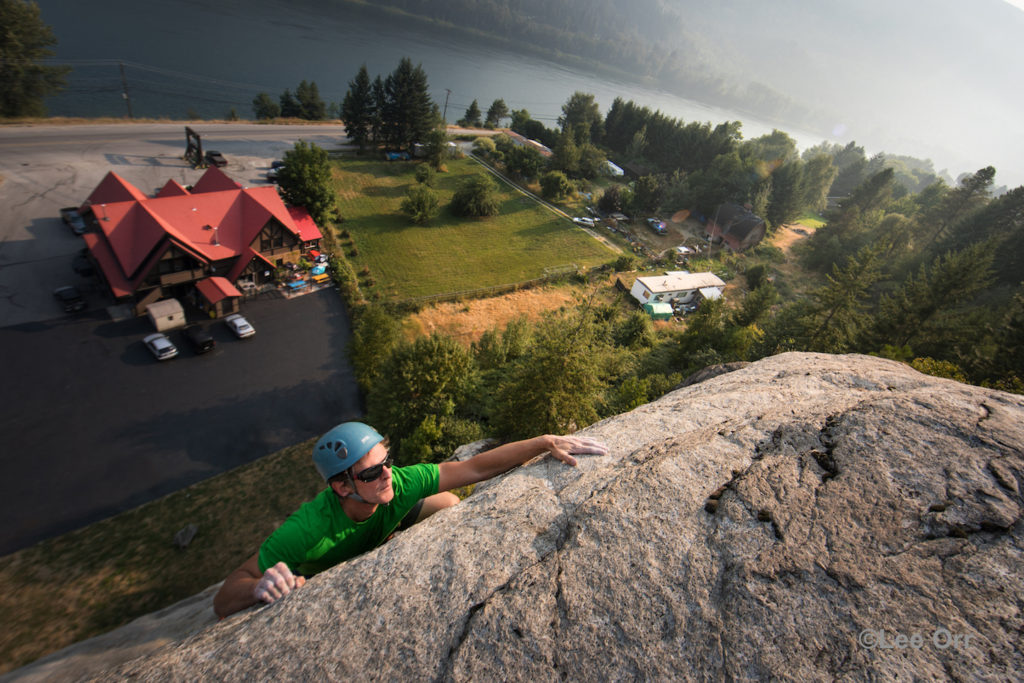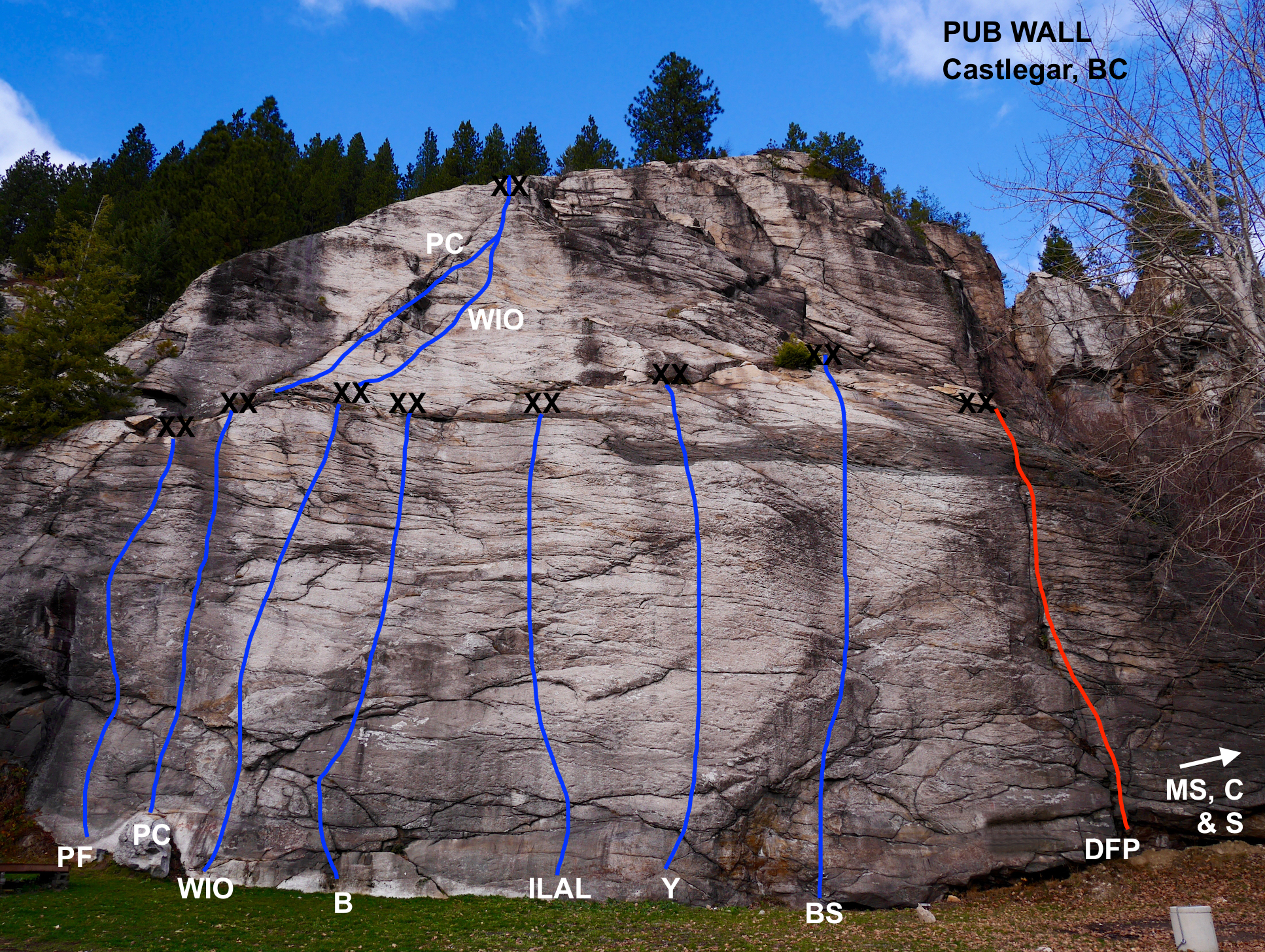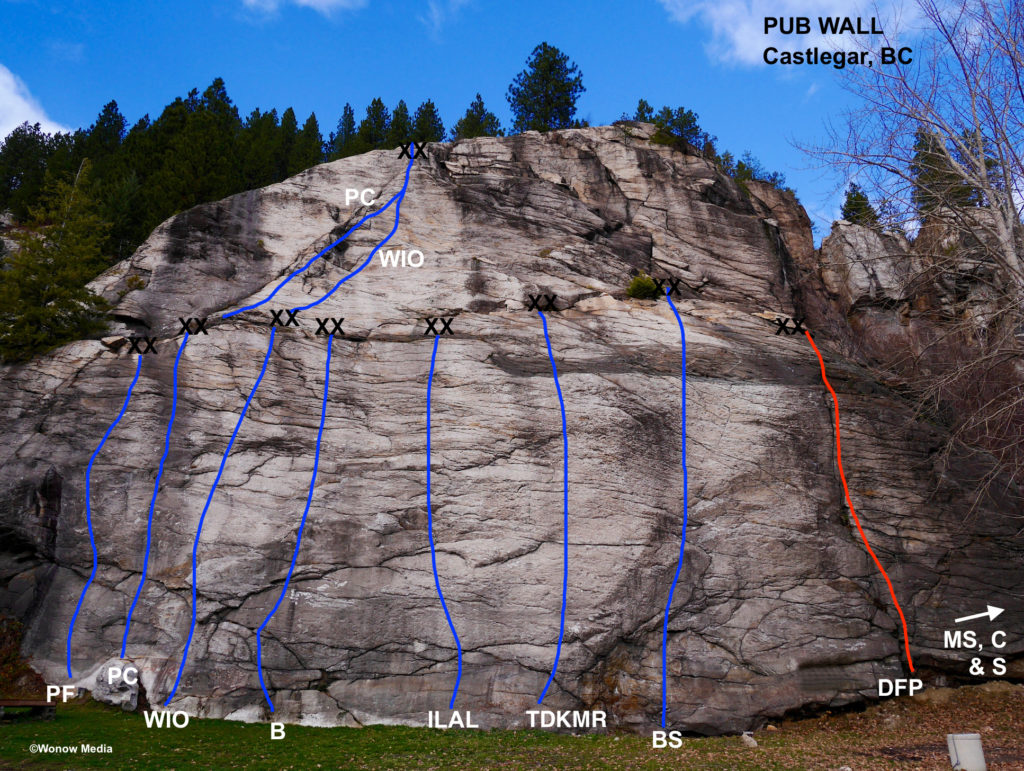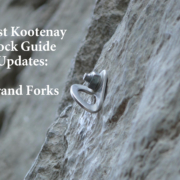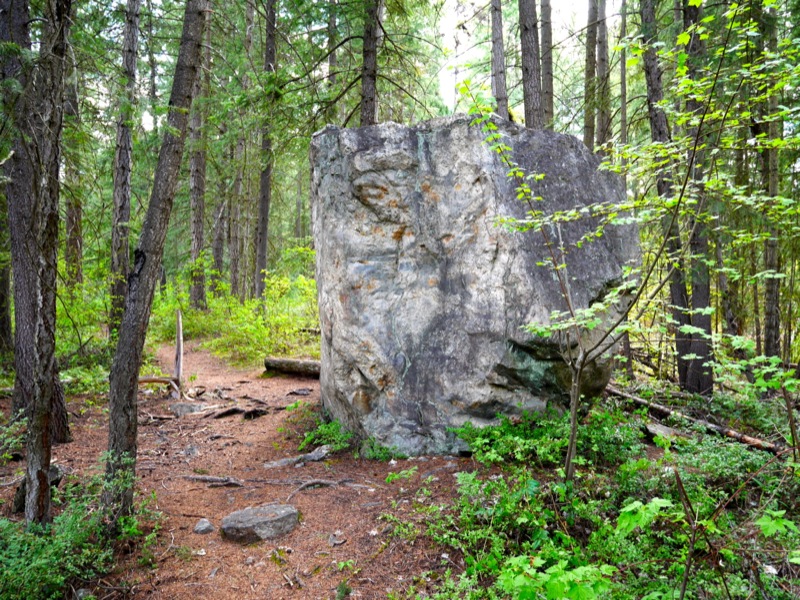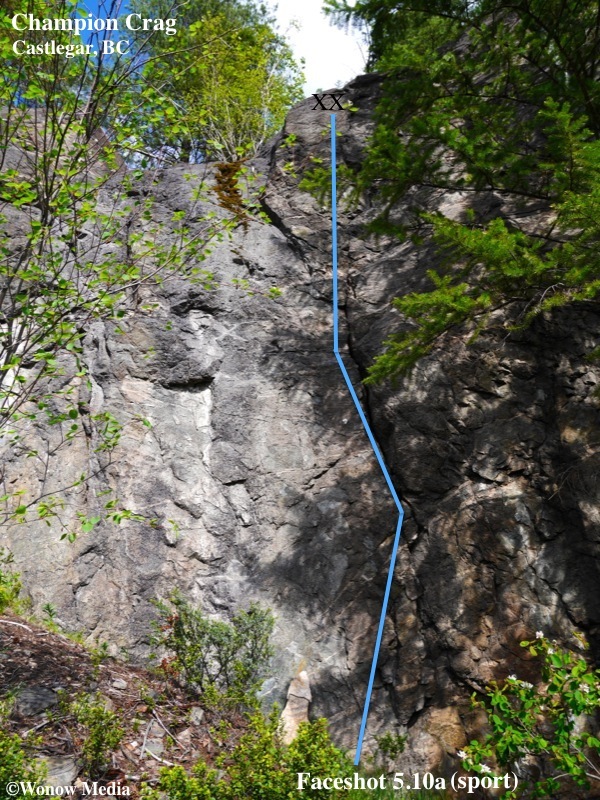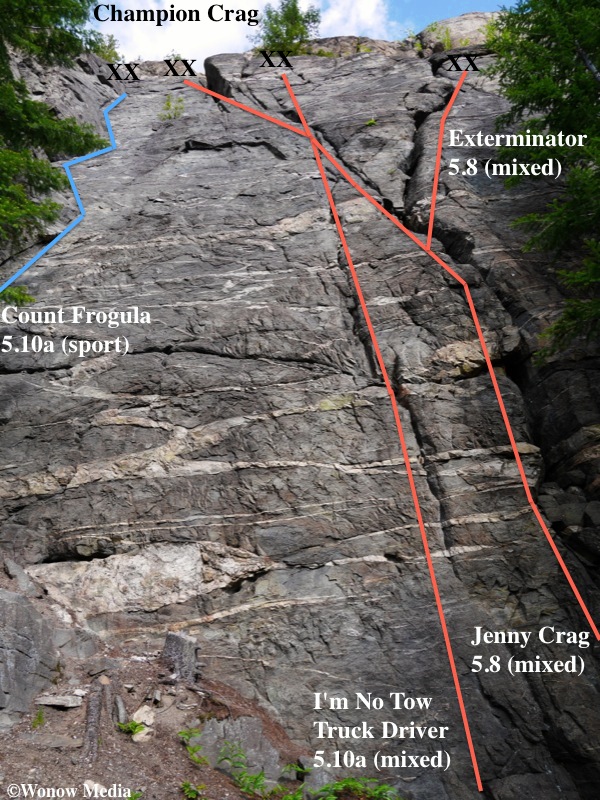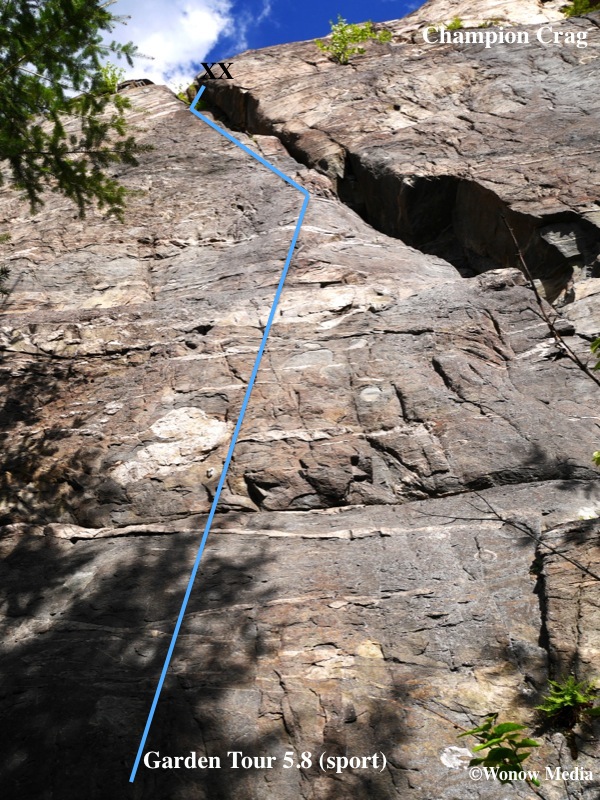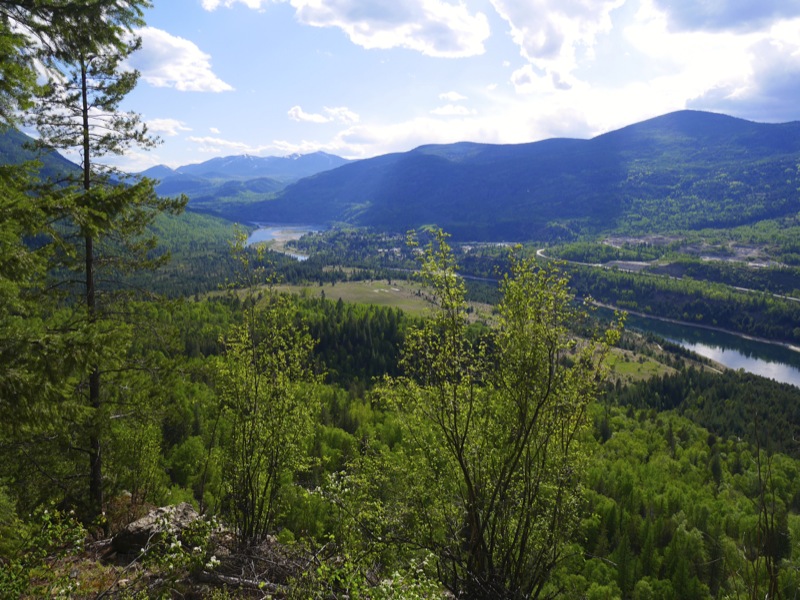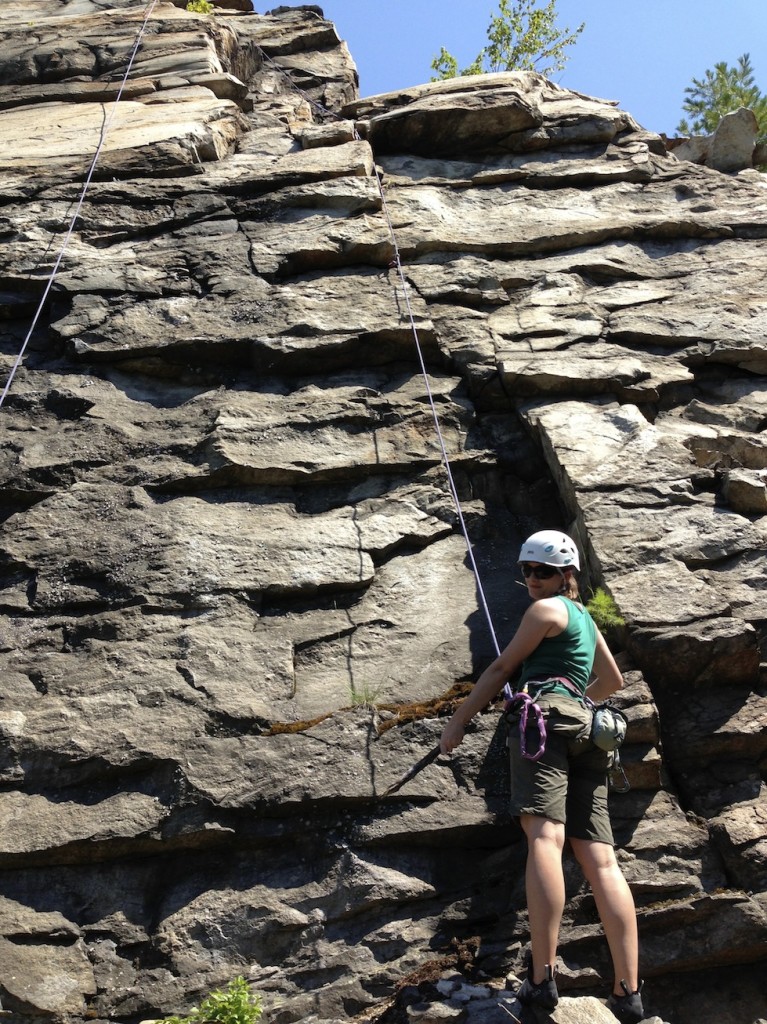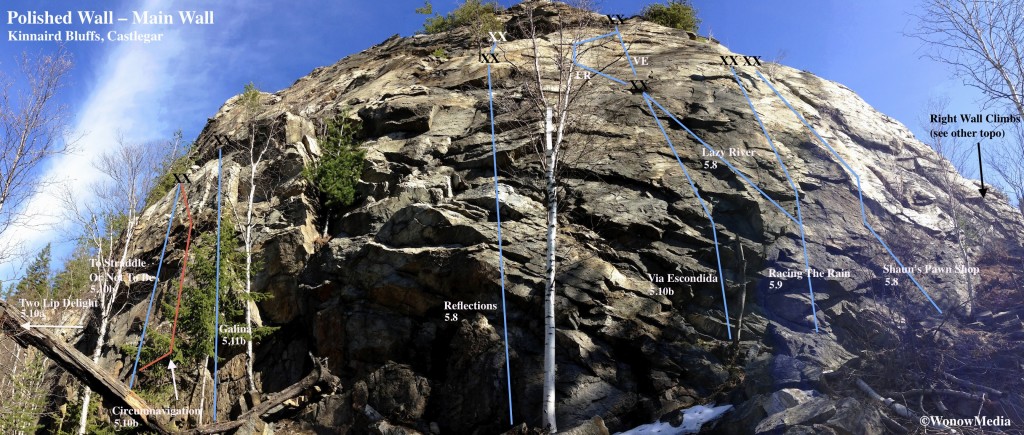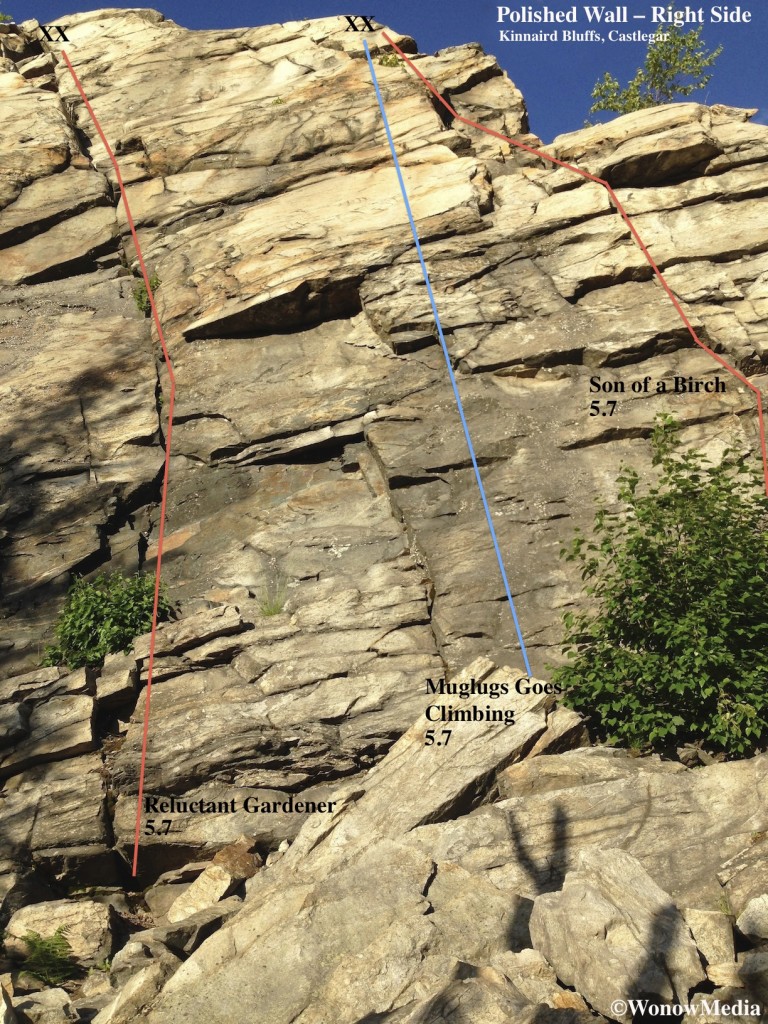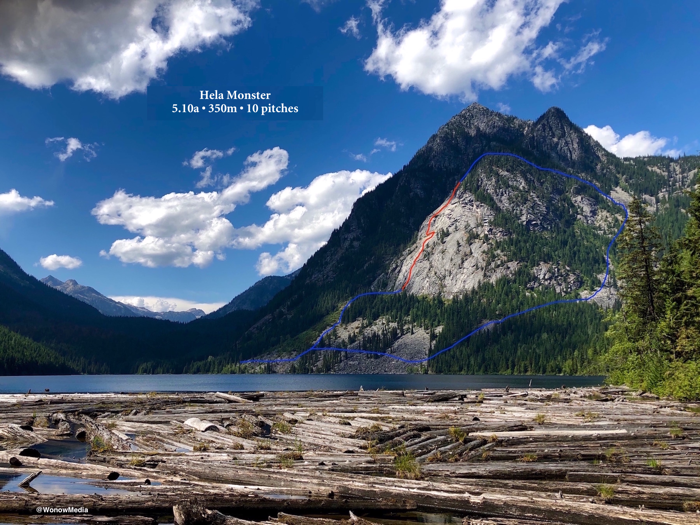
This summer professional photographer Steve Ogle and I climbed a new route up a beautiful swath of virgin slab in Valhalla Provincial Park near Cahill Lake. These are the details.
There’s a giant south-facing slab that can easily be seen from Highway 6 north of the village of Slocan before the S-bend that takes you over Enterprise Creek. It’s impossible to judge from that distance just how large it is but after a recent adventure Steve Ogle and I can now confidently attest to the fact that it’s really, really big. And in 30+ heat, it’s really, really hot.
In August we paddled from Slocan to Evans Creek and then hiked the three hours up the relatively mellow Beatrice Lake Trail. (The only real steep part of the hike is at the beginning as you rise out of the mouth of Evans Creek.) We passed the aptly named Emerald Lake, encountering another short steep hiking section up from its west end, to Cahill Lake in Valhalla Provincial Park. Our objective was the face of a large dome of gneiss on the north shore of the lake that’s backed by the sub-peaks of Hela Peak. It’s a stunning piece of white rock that’s easy to access from the campground at the west end of Cahill Lake. The same day we hiked in we did a recon mission to the base of the wall, scoped a line, stashed some gear, and went back to camp to rest before the next day’s push.
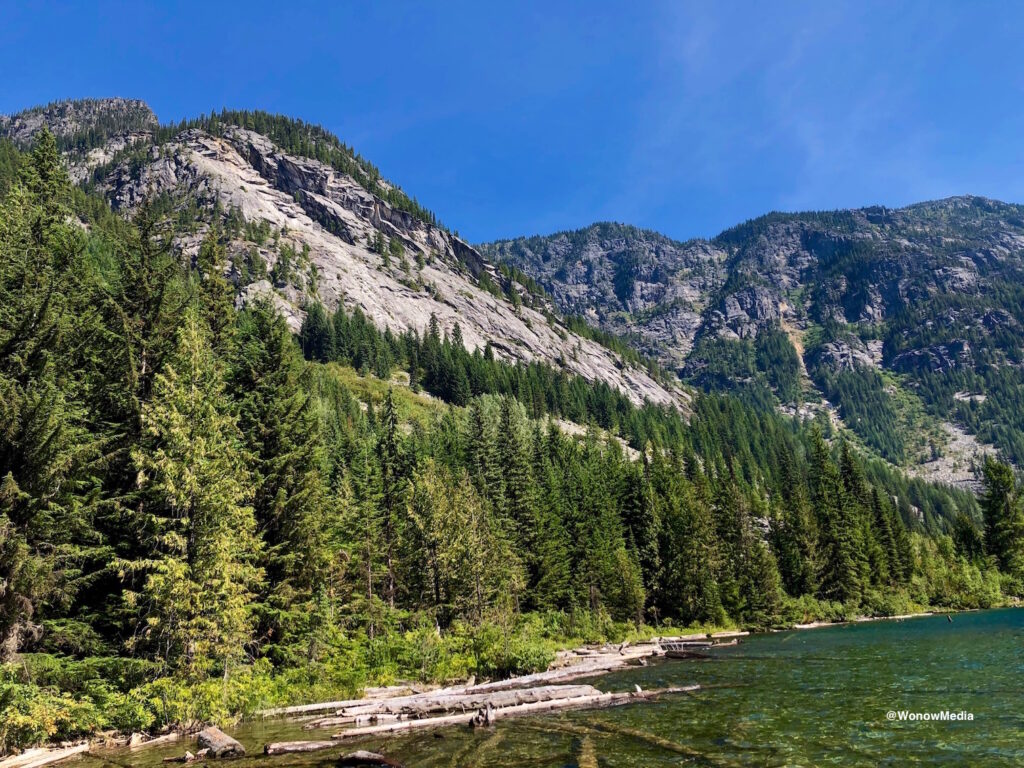
Hela Monster as seen from the Cahill Lake campground.
The next day proved to be a bit longer and hotter than expected. In hindsight, Steve dumping a half litre of water at the start of the route because it was too heavy wasn’t the best idea. Nor was leaving one headlamp at camp. By the time we reached pitch 5, bolting the occasional blank section on lead, the temperature had climbed above 30°C. Luckily there were intermittent clouds but it wasn’t long before I was sucking on the lid of my chapstick trying to trick my brain into believing there was moisture in my mouth. Another five pitches took us near top just as the sun was starting to set. We ate wild blueberries on the fly, savouring the minuscule amounts of moisture they provided, and then stumbled down talus for 1.5 hours using one headlamp and the light from a cellphone, before reaching an unnamed creek where I consumed about three litres of water in 10 minutes. We walked back into camp 15 hours after setting out, toasted the new 10-pitch route with scotch, and collapsed.
Despite our challenges, I highly recommend this climb for those who want an adventure in a beautiful setting up easy slab. There’s only one 5.10a move on the whole route and it’s protected by a bolt. The rest of this monster climb is mostly in the 5.5 to 5.7 range, although you’ll want to be comfortable running out easier sections of slab as gear can be sporadic in places. Oh, and pick a day that’s not super hot.
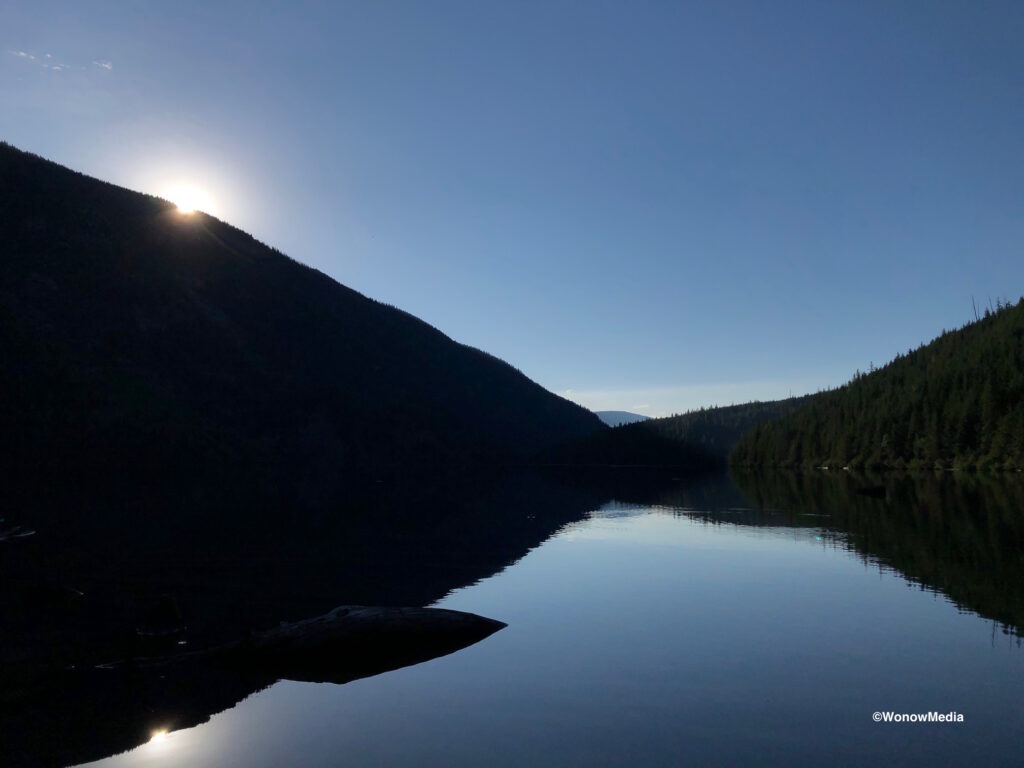
Cahill Lake photographed the morning after the first ascent of Hela Monster.
Hela Monster Route Description
Hela Monster • 5.10a • 350 metres • 10 pitches • South-facing • FA: Steve Ogle, Vince Hempsall August 2020
About The Route Name
Hela is a prominent peak in Valhalla Provincial Park named for the Norse goddess Hela (aka Hel) who is the daughter of Loki and giantess Angrboda and who presides over the realm of the dead. Her appearance is described as half blue and half flesh-coloured, which is appropriate given the views from the route, which include the stunning blue lake and the pasty Slavic-white skin colour of the rock. A Gia Monster (pronounced “Hila Monster”) is one of only two poisonous lizard species in North America, which is also appropriate given this route has bite when you’re climbing it in 30+ heat, like we did.
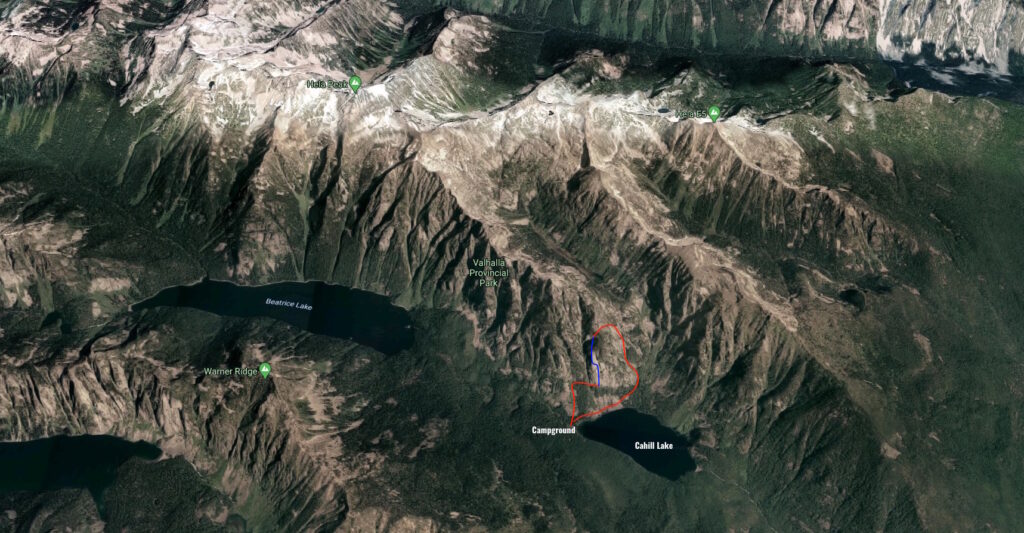
A Google Map topo of the route in blue and the approach and walk-off in red.
About The Climb
Hela Monster is located on a huge slab of granitic gneiss that is solid, textured and clean, except for where dirt has gathered in the cracks. The climbing is mostly in the 5.5 to 5.7 range. Route finding is very easy thanks to all the bolts but protection is sparse on some of the easier terrain. All crux moves are protected. Most stations are bolted but those that do not have either trees or boulders that can easily be slung.
History Of The Area
Slocan Lake and Evans Creek were important fishing grounds for multiple First Nations throughout the centuries as evidenced by the pictographs on the lake’s west shoreline between Slocan Village and Evans. In the 20th Century this area became a hotbed of mining and logging – in fact, the tiered lake systems from Beatrice to the Slocan were flooded and then released so as to move timber down the drainage. The Beatrice Lake hiking trail is an old logging road and there’s still a lot of evidence of the old camps, from rusted cans to rotting machinery. Today the popular hiking trail leads you into Valhalla Provincial Park, which was established in 1983.
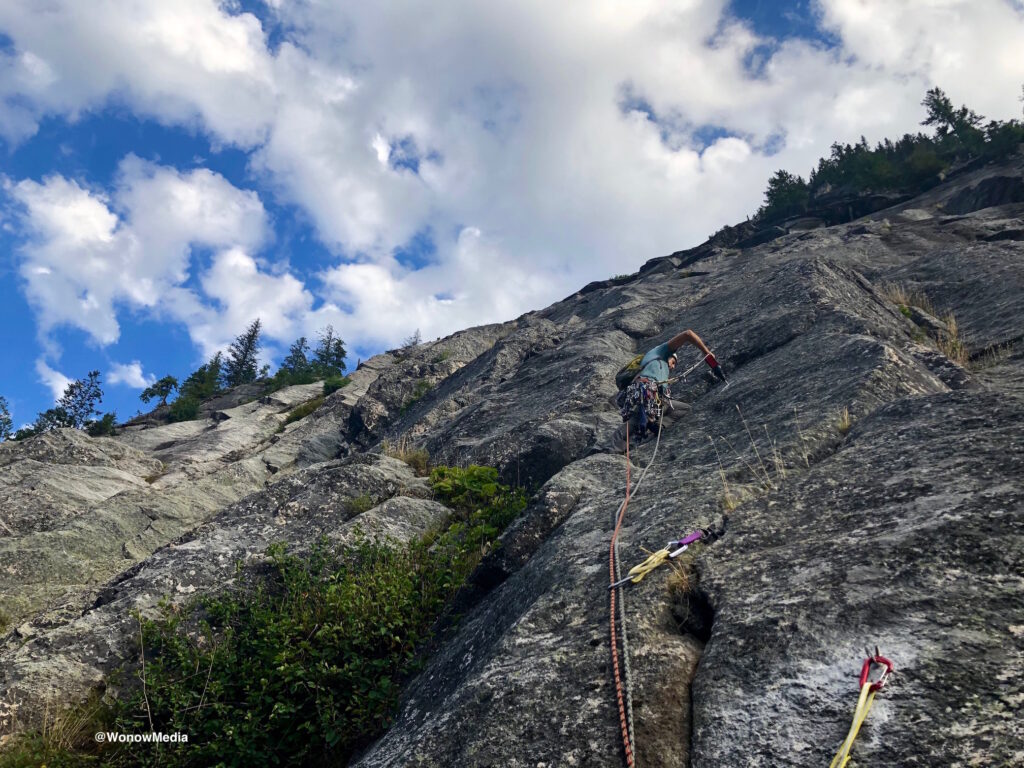
Steve Ogle enjoying bolting on lead for the first time while on the first pitch of Hela Monster. Huge props to Jeff Hammerich for the loan of the drill.
The Approach
From the village of Slocan, boat or hike the 8km trail to Evans Creek Campground. From here, hike the Beatrice Lake Trail 8.5km (800m of elevation gain) past Emerald Lake to Cahill Lake where you’ll find a campground at the west end with six tent pads, an outhouse, and a metal food box. You can see the route from here as it follows the prominent white streak that runs down the slab from the top corner system which is stained brown. The route starts just to the looker’s right of the white streak, next to the lone tree at the bottom of the face. The tree has branches on only one side. From the campsite walk north over the small tributary (it’s easy to cross via logs or boulders) and then veer northeast towards the scree slope. Walk the scree, diagonally up and east until you reach the first line of conifers. To avoid excessive bush-bashing, walk up the scree slope from here until you reach the base of the wall. Follow it east until it slopes back down and you’ll see the tree at the start of the route. Scramble up the grassy gully and then up to the ledge the tree resides on. You’ll see two bolts on the wall directly above you.
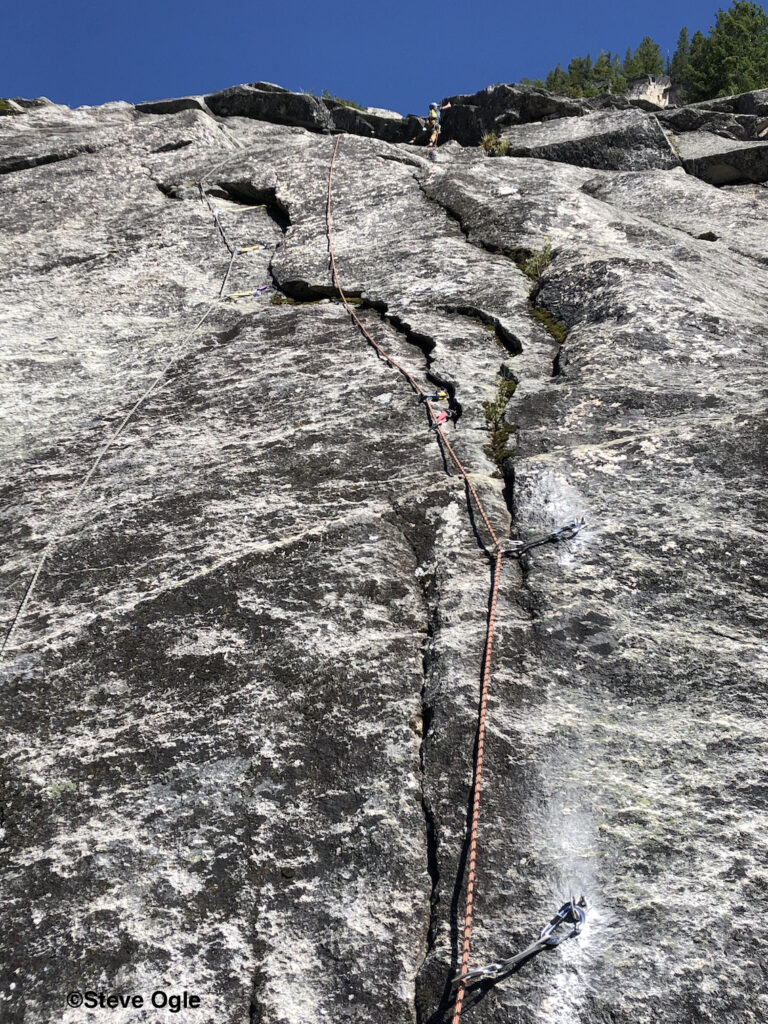
Vince on the crux move of the second pitch of Hela Monster.
The Gear
Take a standard rack to 2” plus doubles of .75 and 1.0 and a rack of nuts. Both climbers should have a nut tool to dig dirt out of cracks for protection if required. Also take 14 draws including 6 extendable ones. One 60-metre rope is all you need if you’re planning to walk off. Take two 60-metre ropes if you want to rap. Be aware rapping is not recommended, however. See descent description below for more info.
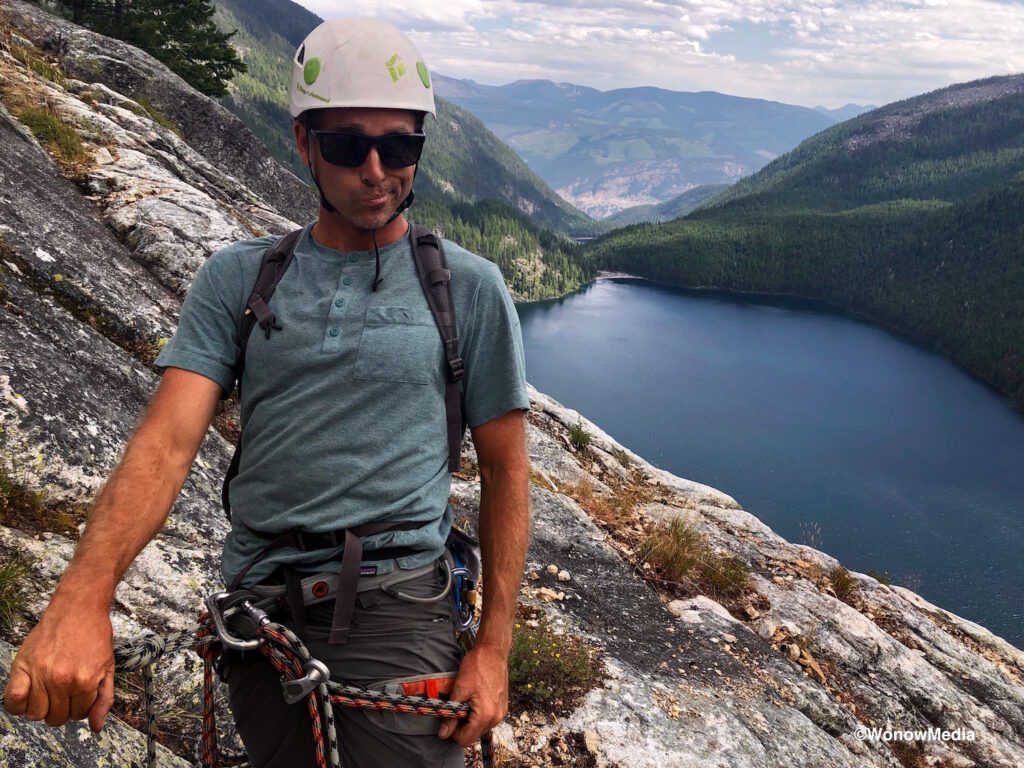
Steve questioning the decision to dump water at the start of the route to save weight as the day’s temperature rises past 30°C.
Pitch Descriptions
Start Location: 49°52’01.5” N 117.33’06.7” W
P1 (58m 5.7): Start at the tree and pass the two bolts. Trend left using sporadic gear and pass three more bolts to finish at a bolted station on a small ledge just below a larger grassy ledge at 58m. There’s one 5.7 move off the deck but otherwise this pitch is in the 5.6 range. 5 bolts
P2 (58m 5.10a): Climb past two bolts then follow the flake, laybacking and jamming through 5.8 terrain until you can step over to easier ground. Continue up, aiming for the V-shaped notch that is past a big left-facing dihedral. Pull a mantle move over the roof, which is protected by a bolt that can only be seen once you’re at the roof. This is the only 5.10a move on the route and can easily be aided. Continue another 10 metres past an additional bolt to a station. 4 bolts
P3 (45m 5.6): Move up a wide corner and then either step left to the arete or continue up the corner. Past this feature is an easy section of slab climbing where protection can be found by the large block to the right if needed. Gain the large ledge and find a two-bolt anchor to the left of a bushy gully.
P4 (58m 5.6): Go directly up a seam and two overlaps, continuing slightly left above to gain more cracks with sparse but adequate protection. Finish on the twin cracks to the right of a whale-like feature and belay by slinging the lone ottoman-sized white boulder.
P5 (30m 5.2): Scramble up low fifth-class terrain to gain a huge ledge that slopes downward slightly to the left. The bolt anchors are about 20m left from where the scramble meets the ledge.
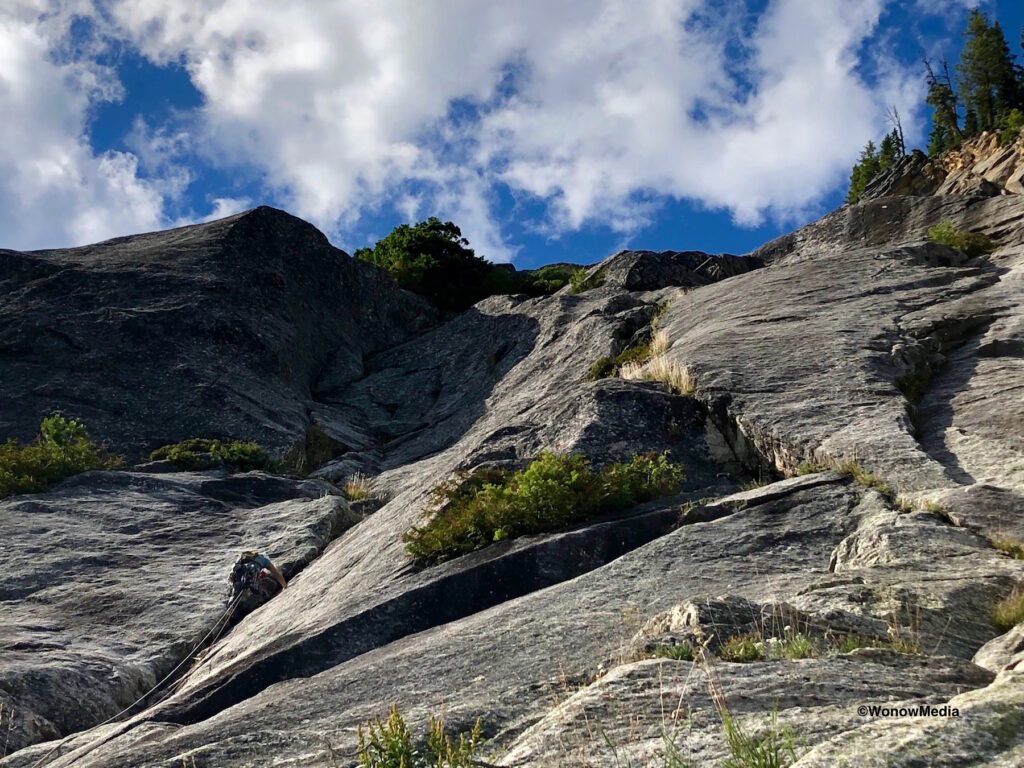
Steve leading the excellent 6th pitch of Hela Monster.
P6 (60m 5.8): From the anchor angle up and left over fourth class terrain (no protection) to gain a broad V-shaped crack system that trends up and left into a right-facing dihedral. Belay from the ledge at a two-bolt anchor at the top of the dihedral.
P7 (60m 5.5): Continue up straight, skirting below and to the right of a large bunch of bushes and trees. Then angle slightly right and up through easy terrain. Aim for an area approximately 10 metres to the left side of a large sloping roof. Belay at a very small tree with a good-sized root ball with a fixed sling.
P8 (58m 5.8): Climb easy terrain and then left onto mellow slabs. There is a bolt in a more blank section of rock at around the 40m mark. Continue left past the bolt and follow a small seam with one small gear placement. Finish up on a ledge with darker rock where there’s a two-bolt anchor. 1 bolt
P9 (60m 5.2): Move up and left over easy ground then walk on the moss-scattered ramp skirting below the treed cliffs as far as you can reach to a fir tree. Sling this and belay.
P10 (60m 4th class): Continue walking uphill and to the right across pine needles, over blocks and around trees until you reach easier ground at the 60m mark. Belay from whatever you can sling. From here it’s an easy walk to the height of land but be careful not to veer too far right towards the cliffs.
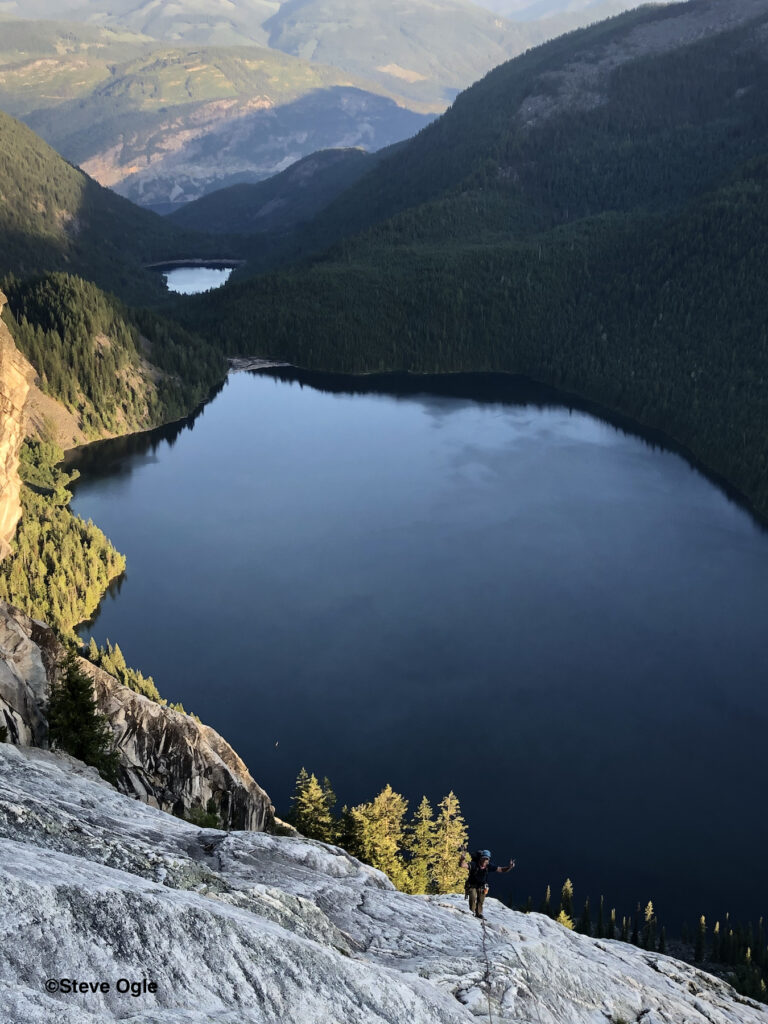
Vince enjoying the relatively mellow terrain of Pitch 8 above Cahill Lake.
The DESCENT
It took the first ascentionists two hours to walk back to the campsite and some of that time was spent in the dark. From the top of pitch 10, continue hiking east up mellow terrain to where the ground flattens out. Once there, walk in a north-east direction past wild blueberry bushes and conifers. Although you’ll be trending slightly downhill, it’s important to stay relatively high as most of the south-east slope cliffs out. Eventually you’ll reach a scree slope that you can follow down, first east and then it swings around south and a creek is on your left. Keep walking towards the lake and when the scree ends, trend southwest through the trees (this is the only heavy bushwhacking you’ll have to endure) to gain the scree slope below the south face of the slope you’ve just climbed. Stay approximately 80 metres above the lake edge for easier walking. Rappelling the route is not recommended because it’s so low angle and the chances of getting your rope stuck are high. However, if you get stuck and need to rappel, remember that all pitches require two 60m ropes. You’ll have to sling trees at the top of P10, P9 and P7 and make an awkward diagonal west-to-east rappel from the anchors at the bottom of P5 to the ottoman-sized boulder at the top of P4. From there rappelling to the base of the route becomes easier.
Here’s a downloadable PDF of the route information for Hela Monster: hela monster full description
A few weeks after the first ascent, Greg Amos and two others climbed the route and provided some feedback on the pitch descriptions. Big thanks to them. Also, they recorded their route and have a KMZ file available. Comment below if you’d like a copy of it.
